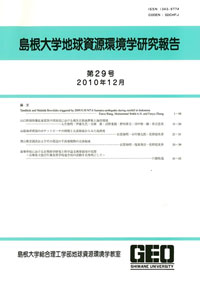島根大学総合理工学部地球資源環境学教室
ISSN:1343-9774

number of downloads : ?
Use this link to cite this item : https://ir.lib.shimane-u.ac.jp/35673
Geoscience reports of Shimane University 34
2016-03-05 発行
Amphiboles from the kyanite-garnet amphibolite in the Tonaru metagabbro mass, Sambagawa metamorphic belt, central Shikoku, Japan
File
Description
The Tonaru metagabbro mass occurs as a large lenticular body in the highest-grade (oligoclase-biotite zone) portions of the Sambagawa schists in the Besshi district. The Tonaru mass consists of diopside amphibolite and garnet-epidote amphibolite accompanied by small amounts of eclogite and marble. Kyanite-garnet amphibolites from the Tonaru metagabbro mass are composed of amphibole (calcic-amphibole; magnesiohornblende, actinolite, tremolite and tschermakite), zoisite, kyanite, garnet, phengite, paragonite, margarite, chlorite, quartz and pyrite. Amphiboles in the kyanite-garnet amphibolite exhibit three different modes of occurrence (Amp1-3). Amphiboles (Amp1) occur as inclusions in the porphyroblastic garnets are calcic in compositions (magnesiohornblende, actinolite and tremolite). Some are zoned, with magnesiohornblende core and actinolite / tremolite rim. Amphiboles (Amp2) in the matrix are mostly magnesiohornblende, and are zoned with magnesiohornblende core and actinolite / tschermakite rim. Amphiboles (Amp3) filling the fractures of the garnets are magnesiohornblende and tschermakite, and display a compositional zoning with magnesiohornblende core and tschermakite rim. The metamorphic evolution of the kyanite-garnet amphibolite from the Tonaru metagabbro mass is probably divided into two metamorphic events. The amphiboles (Amp1, 2) represent prograde metamorphism from the epidote-blueschist facies to the peak eclogite facies metamorphism. The actinolite rim of both occurrences suggests a retrograde metamorphism after the peak conditions. Amphiboles (Amp3) occur in fractures of the porphyroblastic garnets, and provide evidence of the second high-P metamorphic event. This metamorphic event is similar to that of the prograde Sambagawa metamorphism of the oligoclase-biotite zone.
Other Article
PP. xxi - xxiv
PP. 9 - 14
PP. 69 - 75
PP. 89 - 93
